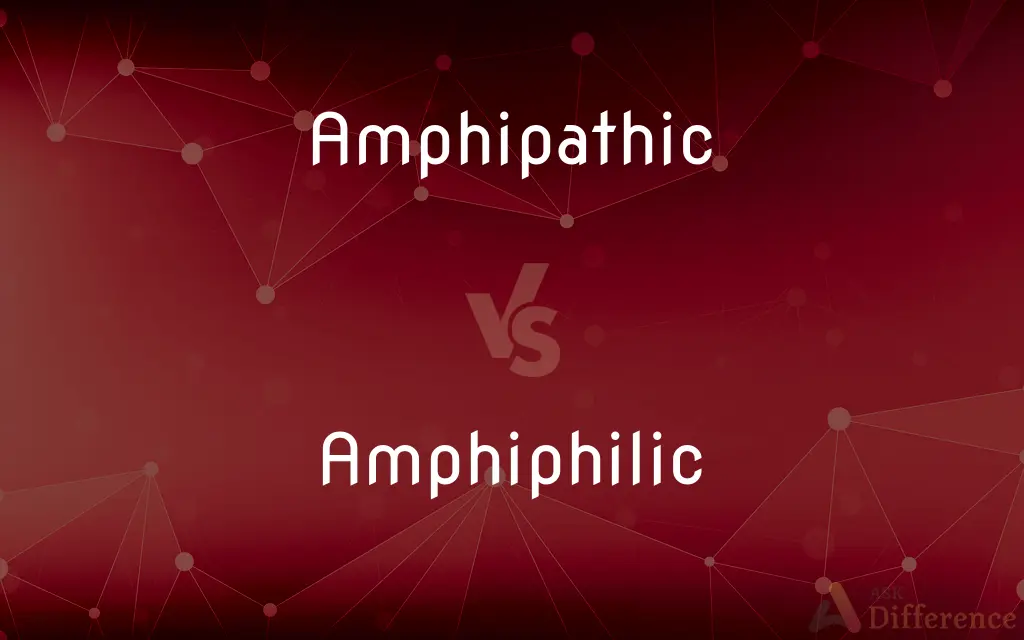Amphipathic vs. Amphiphilic — What's the Difference?
By Urooj Arif & Fiza Rafique — Updated on April 5, 2024
Amphipathic molecules have both hydrophobic and hydrophilic regions, while amphiphilic refers more broadly to compounds loving both water and fat environments.

Difference Between Amphipathic and Amphiphilic
Table of Contents
ADVERTISEMENT
Key Differences
Amphipathic molecules possess distinct hydrophobic (water-repelling) and hydrophilic (water-attracting) regions, enabling them to interact with both water and lipids effectively. This dual characteristic is crucial in biological systems, especially in the formation of cell membranes, where amphipathic molecules, like phospholipids, help create barriers that are selectively permeable to various substances. The hydrophilic heads of these molecules face the aqueous environment, while the hydrophobic tails align away from water, forming a bilayer that is foundational to membrane structure.
Amphiphilic, a term often used interchangeably with amphipathic, generally describes molecules that have an affinity for both water and lipid environments but is sometimes used to emphasize the molecule's ability to dissolve or interact favorably with both polar and nonpolar substances. This characteristic makes amphiphilic compounds essential in forming micelles, emulsions, and vesicles, which are pivotal in various chemical and pharmaceutical processes, including drug delivery systems where they help in transporting hydrophobic drugs in aqueous environments.
The distinction between amphipathic and amphiphilic often hinges on the context in which they are used. In biochemistry, amphipathic is frequently the preferred term, particularly when discussing membrane formation and function. It highlights the structural orientation of molecules that contribute to the complexity of biological membranes. Amphiphilic, while it can be used in similar contexts, is more common in discussions related to surface chemistry and the formulation of compounds that can bridge water and oil phases, such as detergents and emulsifiers.
Despite the subtle differences in usage, the unifying characteristic of both amphipathic and amphiphilic compounds is their critical role in enabling the interaction between hydrophobic and hydrophilic environments. This feature is exploited in various scientific fields, from the study of cellular biology to the development of industrial and pharmaceutical products, showcasing the versatility and importance of these molecules in both natural and synthetic processes.
In exploring the nuances of these terms, it's evident that while they are closely related and sometimes used interchangeably, the context and specific emphasis on interaction mechanisms can guide the preferred usage. Whether discussing the structural components of cell membranes or the properties that make certain substances effective in bridging water and oil phases, understanding the distinction between amphipathic and amphiphilic helps clarify the discussion and enhances the precision of scientific communication.
ADVERTISEMENT
Comparison Chart
Definition
Molecules with both hydrophobic and hydrophilic parts
Compounds that love both water and lipid environments
Key Characteristic
Structural orientation for membrane formation
Ability to dissolve or interact with polar and nonpolar substances
Common Usage
Biochemistry, cellular biology
Surface chemistry, pharmaceuticals
Examples
Phospholipids in cell membranes
Detergents, emulsifiers, drug delivery systems
Role in Biological Systems
Formation of cell membranes, selective permeability
Micelle formation, emulsions, vesicles
Compare with Definitions
Amphipathic
Substances that can interact with both aqueous and lipid environments, due to their dual nature.
Some proteins are amphipathic, allowing them to insert into cell membranes.
Amphiphilic
Materials that can bridge the gap between water-loving and oil-loving substances, used in various industrial applications.
Amphiphilic compounds are key in producing effective cosmetics.
Amphipathic
Chemical compounds with distinct polar and nonpolar sections, facilitating their interaction with both water and oils.
Bile acids are amphipathic, aiding in fat digestion.
Amphiphilic
Substances designed to interact favorably with both hydrophilic and hydrophobic phases.
Amphiphilic coatings on nanoparticles enhance their distribution in biological systems.
Amphipathic
Molecules that contain both hydrophilic (water-loving) and hydrophobic (water-repelling) regions.
Phospholipids are amphipathic, crucial for cell membrane structure.
Amphiphilic
Molecules with the capability to dissolve in both polar and nonpolar solvents, aiding in diverse chemical processes.
Certain surfactants are amphiphilic, stabilizing mixtures of oil and water.
Amphipathic
Molecules that exhibit both attraction and repulsion to water, enabling diverse biological functions.
The amphipathic nature of certain vitamins helps them play roles in various bodily processes.
Amphiphilic
Compounds that are attracted to both water and oil, useful in creating emulsions.
Soap molecules are amphiphilic, allowing them to remove oil and dirt.
Amphipathic
Compounds designed to bridge hydrophilic and hydrophobic environments, often used in biochemical applications.
Synthetic amphipathic polymers can mimic biological membranes.
Amphiphilic
Chemical structures that have affinity for both aqueous and lipid environments, important in drug delivery.
Amphiphilic block copolymers can form micelles for drug encapsulation.
Amphipathic
(chemistry) Describing a molecule, such as a detergent, which has both hydrophobic and hydrophilic groups.
Amphiphilic
Of or relating to a molecule having a polar, water-soluble group attached to a nonpolar, water-insoluble hydrocarbon chain.
Amphipathic
(biochemistry) Of the surface(s) on a protein, particularly an alpha helix, where one surface of the alpha helix has hydrophilic amino acids and the opposite face has hydrophobic (or lipophilic) amino acids.
Amphiphilic
Being a detergent: having both hydrophilic and hydrophobic (or lipophilic) groups.
Amphiphilic
Having one surface consisting of hydrophilic amino acids and the opposite surface consisting of hydrophobic (or lipophilic) ones.
Common Curiosities
Are amphipathic and amphiphilic molecules the same?
While closely related and sometimes used interchangeably, "amphipathic" often emphasizes structural aspects in biological contexts, whereas "amphiphilic" is more broadly about compatibility with both water and lipid environments.
How do amphiphilic compounds benefit pharmaceuticals?
Amphiphilic compounds are used to create micelles and emulsions, facilitating drug delivery by allowing hydrophobic drugs to be transported in aqueous environments.
What is the significance of amphipathic molecules in membrane formation?
Amphipathic molecules enable the formation of bilayers, essential for the structure and function of cell membranes, by orienting their hydrophobic and hydrophilic regions appropriately.
Can a molecule be both amphipathic and amphiphilic?
Yes, a molecule can be described as both, especially if it exhibits the necessary structural features and affinity for interacting with both water and lipid substances.
How does the dual nature of amphipathic molecules affect their behavior in aqueous environments?
Their dual nature allows them to form structures like micelles or bilayers, where hydrophobic tails are shielded from water by hydrophilic heads.
Why is understanding the properties of amphipathic and amphiphilic molecules important?
Understanding these properties is crucial for exploring cellular processes, drug delivery systems, and the development of various industrial and chemical products.
What defines a molecule as amphipathic or amphiphilic?
A molecule is defined as amphipathic or amphiphilic if it possesses both hydrophilic (water-attracting) and hydrophobic (water-repelling) properties.
Can amphipathic properties be engineered synthetically?
Yes, synthetic amphipathic molecules are engineered for specific applications, including drug delivery and the creation of artificial membranes.
How do the properties of amphipathic molecules facilitate digestion and absorption?
Amphipathic molecules like bile acids help emulsify fats in the digestive system, facilitating their breakdown and absorption.
What role do amphipathic molecules play in biology?
Amphipathic molecules, like phospholipids, are crucial in forming cell membranes, enabling selective permeability and compartmentalization within cells.
How do amphipathic and amphiphilic molecules interact in micelle formation?
In micelle formation, the hydrophobic regions cluster together, while the hydrophilic regions face outward, interacting with the aqueous environment.
What makes a molecule preferentially amphipathic or amphiphilic in scientific literature?
The preference often depends on the molecule’s role in the biological system or its application in industrial and chemical processes.
How do amphiphilic substances aid in cleaning and detergency?
Amphiphilic substances, like detergents, can emulsify oils in water, effectively removing grease and dirt by bridging the gap between hydrophobic and hydrophilic substances.
What is the difference in usage between amphipathic and amphiphilic?
"Amphipathic" is more commonly used in biochemistry and cellular biology, while "amphiphilic" is prevalent in surface chemistry and industrial applications.
What advancements in technology have been made possible by understanding amphipathic and amphiphilic molecules?
Advances include the development of targeted drug delivery systems, improved detergents and emulsifiers, and the design of synthetic membranes and nanomaterials.
Share Your Discovery

Previous Comparison
Ironman vs. Triathlon
Next Comparison
Million vs. CroreAuthor Spotlight
Written by
Urooj ArifUrooj is a skilled content writer at Ask Difference, known for her exceptional ability to simplify complex topics into engaging and informative content. With a passion for research and a flair for clear, concise writing, she consistently delivers articles that resonate with our diverse audience.
Co-written by
Fiza RafiqueFiza Rafique is a skilled content writer at AskDifference.com, where she meticulously refines and enhances written pieces. Drawing from her vast editorial expertise, Fiza ensures clarity, accuracy, and precision in every article. Passionate about language, she continually seeks to elevate the quality of content for readers worldwide.
















































